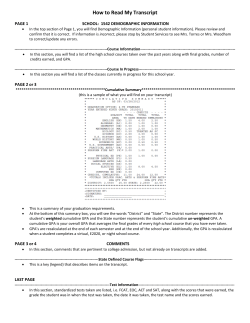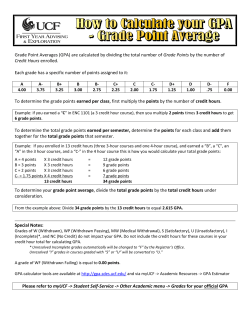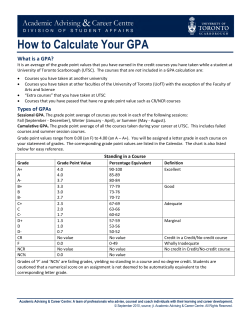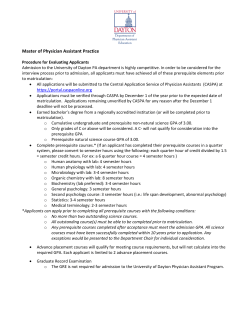
How to calculate your GPA
How to calculate your GPA This section explains how to calculate your GPA. In general this information applies to all medical schools and the Doctor of Dental Surgery at the University of Melbourne, but please note local variations outlined on university websites and in the university-specific information pages in the Medicine Admissions Guide. The Doctor of Optometry at the University of Melbourne uses a Weighted Average Mark (WAM) so this information is not relevant for that. You can use this information to create your own GPA calculator in a spreadsheet, or you can use an on-line GPA calculator. GEMSAS will use percentage results to calculate your GPA and will use grades only where percentage results are not provided on transcripts or results retrieved electronically through ARTS. Your GPA calculation will be an estimation for your information only. Before you calculate your GPA, you should read the sections in the Admissions Guide: ‘Before You Apply’ and ‘How To Apply’ Although some schools use postgraduate studies in GPA calculations, these instructions are for undergraduate studies. You can follow the instructions given here for undergraduate study and use the same principles to calculate your GPA using your postgraduate results if you are applying for one of the schools that use them. Please see the Admissions Guide for this information. Step One Group your subjects into GPA years. 3 year Bachelor degrees Where applicants have undertaken a Bachelor degree which can normally be completed in 3 years of full-time study (e.g. Commerce, Arts), all the subjects studied in this degree will be used in the GPA calculations. For example, if your degree is a 3 year BSc comprising 300 credit points of completed units or subjects, you should divide your subjects or units into 3 groups of about 100 credit points each, based on the order you completed them. Any failed or repeated subjects should be included. The three years of equivalent full-time study are known as “Final-minus-2”, “Final-minus-1” and “Final” years. Longer courses Applicants who have completed degrees of more than 3 years in duration – e.g. Law, Engineering – should only use the subjects which comprise the last 3 full time equivalent years of study. If you completed a 5 year full time Engineering degree, you should not include the subjects in your first or second years of full time equivalent study. Similarly, if you undertook a one year full time equivalent Honours course after finishing a 3 year Bachelor degree, you should not include the subjects studied in the first year of your Bachelor degree. If your course was a five year Engineering degree comprising 180 credit points, you should divide the subjects or units into 5 groups of about 36 credit points each. The subjects or units in the first two groups will not be included in the GPA calculations. Study in the current year If you are completing your qualifying degree this year and already have your first semester results, you should include them in your GPA calculations. They will typically only constitute half of the Final year results. If you current study is an honours year, you will most likely have no first semester results. You should calculate your GPA using your bachelor degree results. Check school entries in the Admissions Guide for information about how they may use honours results from current study. Part-time study If you completed a 3 year BSc over 6 years of part time study, you should still divide all the subjects or units into 3 roughly equal groups, based on the order you completed them. These groups constitute your Final-minus-2, Final-minus-1 and Final years. If you have completed a combined degree or transferred between different universities or courses, or have received credit for prior studies (including study abroad or exchange semesters), you must record all such enrolments within the relevant three year full-time-equivalent period. Note that you will need to provide all relevant official transcripts for any study undertaken at a university that is not a participant in ARTS (see Appendix A). Note that it may be difficult for you to estimate a GPA in this circumstance. Step Two Enter the credit points and actual marks or grades for each subject or unit Using the groupings of subjects or units described in Step 1 above, list the subjects or units making up the last three full time equivalent years of study in chronological order, in their year groupings. All results from the last three full time equivalent years of study, including fails and repeated subjects, must be included. For each subject or unit enter the subject name or subject code. Remember that the “GPA Year” refers to Final-minus-2, Final-minus-1 and Final years, so each GPA year may include subjects or units taken in different calendar years, particularly if you have studied part-time. It may also include subjects taken at different levels. For instance you may have taken a first-year subject in the final year of your degree so that will be counted in the Final GPA year. Unit value of subject Each degree is made up by a certain number of subjects or units, credit points or contact hours, with subjects or units offered at the first, second and third academic year levels (for a three-year bachelor degree). Enter the unit value or credit points value of each subject or unit, as these appear on your transcript. Actual result Enter the actual result received in each subject exactly as reported on the transcript (e.g. DN, or 76). When both letter grades and percentages are given, use the percentages. If you have only letter grades you will use those. From the conversion table (Appendix A) find the GPA for each subject. You will now have the following information for each subject: Subject name/code Credit points/unit values Result (as a percentage or grade) GPA (from the conversion table) Step Three The GPA calculation You will now create an additional data item for each subject by multiplying the GPA by the credit points. You will now have the following information for each subject: Subject name/code (U) Credit points/unit values Result (as a percentage or grade) GPA (from the conversion table) (P) Value of GPA x credit points (i) Add the unit values (credit points)of all subjects or units (including those failed and/or repeated) within each GPA year. (= Total U1 + U2 + U3 …) (ii) Add the Values of GPA grades x credit points (including those failed and/or repeated) for all subjects within each GPA year. (= Total P1 + P2 + P3 …) (iii) To calculate the GPA for Final-minus-2 year, divide the total of P values by the total of U values (GPA =P/U) (iv) Repeat this calculation for each GPA year. You should now have three GPAs (for Final-minus-2, Final-minus-1 and Final years). Weighted GPA Most universities (refer to individual university-specific information in this Guide) use a weighted GPA, calculated as follows: ((Final-minus-2 GPA x1) + (Final-minus-1 GPA x2)) + (Final GPA x3))/6 Unweighted GPA For those universities that use unweighted GPAs, simply find the average of the three GPAs ((Final-minus-2 GPA + Final-minus-1 GPA + Final GPA )/3 Appendix A: Undergraduate Grading System Conversion Table A 100% 99 98 97 96 95 94 93 92 91 90 89 88 87 86 85 84 83 82 81 80 79 78 77 76 75 74 73 72 71 70 69 68 67 66 65 64 63 62 61 60 59 58 57 56 55 54 53 52 51 50 49 48 47 46 45 <44# GPA 7.0 7.0 7.0 7.0 7.0 7.0 7.0 7.0 7.0 7.0 7.0 7.0 7.0 7.0 7.0 7.0 7.0 7.0 7.0 7.0 7.0 6.5 6.5 6.5 6.5 6.5 6.0 6.0 6.0 6.0 6.0 5.5 5.5 5.5 5.5 5.5 5.0 5.0 5.0 5.0 5.0 4.5 4.5 4.5 4.5 4.5 4.0 4.0 4.0 4.0 4.0 3.5* 3.5* 3.5* 3.5* 3.5* 0 B C HD/7 7.0 D E HD 7.0 F D 6.75 H HD 7.0 HD/≥7/A 7.0 D/6 6.75 G HI 7.0 ≥8 7.0 D 6.75 H2A 6.5 D/DI/6/B/DN 6.25 CR/5 5.75 A+/A/A7.0 B+ 6.5 7 6.25 H2B 6.0 B 6.0 H3 5.5 B5.5 CR 5.75 C 5.5 CR/5/C 5.25 6 5.25 C+ 5 Pass Div 1 4.75 P/4 4.5 P 4.5 P 4.25 P/PA/4 4.25 C 4.5 5 4.25 Pass Div 11 4.0 UP/CQ/PC/3 3.5 F/N/<3 0 F/N 0 C4.0 PC 3.5 CP/3/NC/ PC/C*/NI 3.5 F 0 F/2/I/N/N2 0 F/N 0 PC/PX 3.5 D 3.5 F 0 E 0 * Conceded pass, faculty pass, etc. – GPA grade of 3.5. Otherwise GPA of zero # If you have a percentage mark where the minimum for an unrestricted pass grade is 50 per cent, use column A to read off the corresponding GPA grade. Honours degree (for Griffith or used only where no subject results are available) Award First 2A 2B Third GPA Grade 7.0 6.0 5.0 4.0 Conversion Table Code (only where no subject results are available) Column A B C D E F G H Use Column A if you have an official record of your mark (percentage) ACU, Adelaide, Bond, Canberra, Central Queensland, Charles Sturt, Flinders, Griffith, James Cook, Macquarie, Newcastle, New England, NSW, Notre Dame, Queensland, QUT, Southern Cross, Southern Queensland, Sunshine Coast, Swinburne, Sydney, UTS, Western Sydney, Wollongong South Australia Charles Darwin ANU, Ballarat, Deakin, Edith Cowan, La Trobe, Monash, Murdoch, RMIT, Tasmania, Victoria, Western Australia Melbourne Curtin New Zealand universities and Polytechnics
© Copyright 2025

















